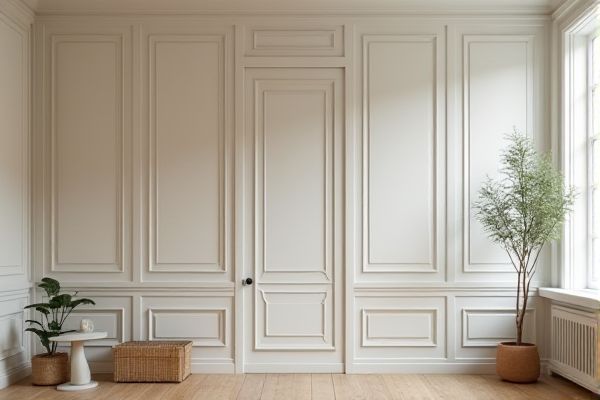
Panel boards provide a sleek, solid surface ideal for clean, modern designs, while louvered panels offer better ventilation and add a decorative element with their angled slats. Explore the rest of the article to understand which option best fits Your needs and design preferences.
Table of Comparison
| Feature | Panel Board | Louvered Panel |
|---|---|---|
| Design | Solid, flat surface panel | Slatted design with angled openings |
| Ventilation | Minimal to none | High airflow and ventilation |
| Privacy | High privacy and coverage | Moderate privacy due to slats |
| Use Case | Wall coverings, displays, partitions | Outdoor fencing, sunshades, ventilation panels |
| Material Options | Wood, MDF, plywood, metal | Wood, metal, vinyl |
| Weather Resistance | Variable, depends on material | Excellent airflow reduces moisture buildup |
| Installation | Simple to install and finish | Requires precise angle placement for louvers |
| Aesthetic | Clean, solid look | Modern, textured appearance |
Introduction to Panel Boards and Louvered Panels
Panel boards consist of flat, solid surfaces used in electrical enclosures or wall claddings, providing a protective and clean finish for equipment and installations. Louvered panels feature angled slats designed for ventilation, enabling airflow while preventing debris and moisture from entering enclosures or spaces. Both panel boards and louvered panels serve distinct functional purposes, with panel boards primarily focusing on protection and aesthetics, while louvered panels optimize airflow and environmental resistance.
Key Differences Between Panel Boards and Louvered Panels
Panel boards offer solid construction designed for maximum security and protection of electrical components, while louvered panels feature slatted openings for enhanced ventilation and airflow. You should choose panel boards for environments requiring dust and moisture resistance, whereas louvered panels are ideal for applications prioritizing heat dissipation and cooling. The primary difference lies in their design focus: panel boards emphasize enclosure integrity, and louvered panels prioritize ventilation efficiency.
Structural Design Comparison
Panel boards feature a solid, flat surface that provides enhanced structural rigidity and load-bearing capacity, making them suitable for applications requiring durability and impact resistance. Louvered panels incorporate angled slats that allow ventilation while maintaining moderate strength, ideal for environments prioritizing airflow and heat dissipation. The choice between panel board and louvered panel hinges on the balance between structural support needs and ventilation requirements in a given architectural or industrial setting.
Material Options and Durability
Panel boards typically come in materials like steel, aluminum, and wood, offering high durability and resistance to impact, making them suitable for heavy-duty applications. Louvered panels are often made from aluminum or steel with powder-coated finishes, designed to provide ventilation while maintaining structural strength and corrosion resistance. Your choice depends on whether durability in harsh environments or optimal airflow is the primary requirement.
Installation Processes
Panel board installation involves mounting a solid, flat surface securely onto a frame or wall, often requiring precise alignment and anchoring using screws or nails to ensure structural stability. Louvered panel installation demands careful positioning to maintain proper airflow, with each slat needing accurate spacing and angle alignment, typically attached using brackets or clips for ventilation optimization. Both installations necessitate measuring, leveling, and securing, but louvered panels require additional consideration for ventilation effectiveness and environmental exposure.
Ventilation and Airflow Capabilities
Panel boards typically offer limited ventilation due to their solid construction, which restricts airflow and may cause overheating in enclosed spaces. Louvered panels are specifically designed with angled slats that promote superior ventilation and airflow, allowing heat dissipation and air circulation while preventing debris and moisture ingress. Improving your system's cooling efficiency and preventing equipment damage depends on selecting the appropriate panel type based on ventilation requirements.
Aesthetic Considerations
Panel boards offer a sleek, uniform appearance that complements modern and minimalist interior designs, providing a smooth surface that can be painted or finished to match any decor. Louvered panels introduce texture and depth through their angled slats, enhancing ventilation while adding a dynamic architectural element often favored in traditional and rustic settings. Both options balance aesthetic appeal with functional benefits, but the choice largely depends on the desired style and visual impact within the space.
Cost Analysis and Budgeting
Panel boards generally offer a lower initial cost compared to louvered panels, making them a budget-friendly option for projects with tight financial constraints. Louvered panels, while more expensive upfront due to their design complexity and ventilation features, can reduce long-term costs by improving air circulation and energy efficiency. Evaluating total cost of ownership, including installation, maintenance, and operational savings, is essential for accurate budgeting and value assessment.
Applications in Residential and Commercial Settings
Panel boards are commonly used in both residential and commercial settings for distributing electrical power safely and efficiently, accommodating circuit breakers and fuses in a centralized location. Louvered panels, favored in commercial HVAC and ventilation systems, provide efficient airflow management while protecting equipment from debris and enhancing aesthetic appeal. Their application distinctly supports electrical safety in homes and offices versus airflow optimization in commercial environments.
Choosing the Right Panel Solution for Your Project
Selecting the appropriate panel solution depends on the specific requirements of airflow, aesthetics, and security. Panel boards offer a solid, durable surface ideal for hiding equipment or creating clean, uninterrupted walls, while louvered panels provide enhanced ventilation and airflow control suitable for HVAC applications or outdoor enclosures. Evaluating factors such as environmental conditions, functional needs, and design preferences ensures the right choice between panel boards and louvered panels for optimal project performance.
 homyna.com
homyna.com